Hyponatremia in Young Patients with Pulmonary Tuberculosis and Tuberculous Meningoencephalitis
DOI:
https://doi.org/10.19184/ams.v9i3.41104Abstract
Pulmonary tuberculosis (PTB) is an uncommon respiratory infection that rarely leads to the development of hyponatremia, a condition characterized by low levels of sodium in the blood. In most cases symptoms andiated hyponatremia are mild to moderate, often lacks noticeable symptoms, and can be effectively reversed through treatment with anti-TB medications. Hyponatremia is diagnosed when the serum sodium level falls below 135 mmol/L, and it is considered severe when the level drops below 125 mmol/L. Among electrolyte imbalances, hyponatremia is one of the most frequently observed, with a prevalence ranging from 1 to 4% in its severe manifestation. This journal reports the case of a male patient who presented with decreased consciousness, suspected to be associated with moderate hyponatremia, tuberculous meningoencephalitis, pulmonary tuberculosis, and sinus bradycardia. The patient's symptoms associated with hyponatremia were relatively mild, prompting the need for further evaluation to ascertain the root cause of the electrolyte imbalance. This is particularly important for patients with suspected tuberculosis who are also experiencing complications related to hyponatremia.
Downloads
References
Bal, C., Gompelmann, D., Krebs, M., Antoniewicz, L., Guttmann-Ducke, C., Lehmann, A., Milacek, C. O., Gysan, M. R., Wolf, P., Jentus, M. M., Steiner, I., & Idzko, M. (2022). Associations of hyponatremia and SIADH with increased mortality, young age and infection parameters in patients with tuberculosis. PLoS ONE, 17(10 October), 1–13. https://doi.org/10.1371/journal.pone.0275827
Chaya, B., Rajesh, K., Mohan, K., & Mahesh, D. (2018). Hyponatremia in tuberculosis: Focus on brain instead of adrenals. Neurology India, 66(5), 1515–1516. https://doi.org/10.4103/0028-3886.241340
Cui, H., He, G., Yang, S., Lv, Y., Jiang, Z., Gang, X., & Wang, G. (2019). Inappropriate Antidiuretic Hormone Secretion and Cerebral Salt-Wasting Syndromes in Neurological Patients. Frontiers in Neuroscience, 13(November), 1–11. https://doi.org/10.3389/fnins.2019.01170
Dash, M., Sen, R. K., Behera, B. P., & Sahu, S. S. (2019). Prevalence of hyponatremia in pulmonary tuberculosis. International Journal of Advances in Medicine, 7(1). https://doi.org/10.18203/2349-3933.ijam20195638
Ewa, A. U., Ochang, E. A., Inaku, K. O., Adams, E. B., Anachuna, K. C., Imoke, E. J., Cobham, A. I., & Brown, E. S. (2021). Challenges of Diagnosing Hyponatremic Syndromes in Pulmonary and Extra Pulmonary Tuberculosis. Journal of Child Science, 11(1), E14–E17. https://doi.org/10.1055/s-0040-1721786
Ganiger, A., Patil, L., & Mrudula, N. (2019). Evaluation of Serum Electrolyte Status among Normal Healthy Individuals and Newly Diagnosed Cases of Pulmonary TB in Tertiary Care Hospital in Bidar: An Observational Study. Indian Journal of Medical Biochemistry, 23(3). https://doi.org/10.5005/jp-journals-10054-0111
Gurnurkar, S., Villacres, S., Warner, L., & Chegondi, M. (2018). Successful Use of Fludrocortisone in a Child with Refractory Cerebral Salt Wasting Syndrome: A Case Report and Review of Literature. Cureus, 10(10), 2–5. https://doi.org/10.7759/cureus.3505
Hannon, M. J., & Thompson, C. J. (2019). Hyponatremia in neurosurgical patients. Frontiers of Hormone Research, 52, 143–160. https://doi.org/10.1159/000493244
Imran, D., Hill, P. C., McKnight, J., & van Crevel, R. (2020). Establishing the cascade of care for patients with tuberculous meningitis. In Wellcome Open Research (Vol. 4). https://doi.org/10.12688/wellcomeopenres.15515.1
Jafari, N. J., Izadi, M., Sarrafzadeh, F., Heidari, A., Ranjbar, R., & Saburi, A. (2013). Hyponatremia due to pulmonary tuberculosis: Review of 200 cases. Nephro-Urology Monthly, 5(1). https://doi.org/10.5812/numonthly.7091
Lee, Y., Yoo, K. D., Baek, S. H., Kim, Y. G., Kim, H. J., Ryu, J. Y., Paek, J. H., Suh, S. H., Oh, S. W., Lee, J., Jhee, J. H., Suh, J. S., Yang, E. M., Park, Y. H., Kim, Y. L., Choi, M., Oh, K. H., & Kim, S. (2022). Korean Society of Nephrology 2022 Recommendations on Controversial Issues in Diagnosis and Management of Hyponatremia. Electrolyte and Blood Pressure, 20(1). https://doi.org/10.5049/EBP.2022.20.1.21
Liangos, O., & Madias, N. E. (2021). Severe symptomatic hyponatremia due to cerebral salt wasting syndrome in a patient with traumatic head injury and Dandy-Walker malformation of the brain. Clinical Nephrology – Case Studies, 9(01). https://doi.org/10.5414/cncs110146
Mentrasti, G., Scortichini, L., Torniai, M., Giampieri, R., Morgese, F., Rinaldi, S., & Berardi, R. (2020). Syndrome of inappropriate antidiuretic hormone secretion (Siadh): Optimal management. In Therapeutics and Clinical Risk Management (Vol. 16). https://doi.org/10.2147/TCRM.S206066
Miller, B. S., Spencer, S. P., Geffner, M. E., Gourgari, E., Lahoti, A., Kamboj, M. K., Stanley, T. L., Uli, N. K., Wicklow, B. A., & Sarafoglou, K. (2020). Emergency management of adrenal insufficiency in children: Advocating for treatment options in outpatient and field settings. In Journal of Investigative Medicine (Vol. 68, Issue 1). https://doi.org/10.1136/jim-2019-000999
Misra, U. K., Kalita, J., Aarnoutse, R. E., Anderson, S. T. B., Bahr, N. C., Bang, N. D., Boulware, D. R., Boyles, T., te Brake, L. H. M., Chandra, S., Chow, F. C., Cresswell, F. V., van Crevel, R., Davis, A. G., Dian, S., Donovan, J., Dooley, K. E., Figaji, A., Rizal Ganiem, A., … Wilkinson, R. J. (2019). Mechanism, spectrum, consequences and management of hyponatremia in tuberculous meningitis. Wellcome Open Research, 4, 1–21. https://doi.org/10.12688/wellcomeopenres.15502.1
Oh, H. S., & Seo, W. S. (2020). An Integrative Review of Cerebral Salt Wasting Syndrome. In Journal of Neuroscience Nursing (Vol. 52, Issue 6). https://doi.org/10.1097/JNN.0000000000000548
Rudolph, A., & Gantioque, R. (2018). Differentiating between SIADH and CSW Using Fractional Excretion of Uric Acid and Phosphate: A Narrative Review. Neuroscience and Medicine, 09(02), 53–62. https://doi.org/10.4236/nm.2018.92007
So, P. N. H., & Villanueva, A. R. T. (2021). Serologic and urinary characteristics of laboratory-confirmed genitourinary tuberculosis at a tertiary hospital in the Philippines. BMC Urology, 21(1). https://doi.org/10.1186/s12894-021-00888-3
WHO. (2019). WHO guidelines on tuberculosis infection prevention and control, 2019 update. Online annexes. In Who-1.
Wilke, R. A. (2021). Potential use of pharmacogenetics to reduce drug-induced syndrome of inappropriate antidiuretic hormone (Siadh). Journal of Personalized Medicine, 11(9). https://doi.org/10.3390/jpm11090853
Ye, Q., Peng, X., Zhang, X., Cao, Q., Tao, K., & Wang, L. (2022). Clinical analysis of 103 cases of tuberculous meningitis complicated with hyponatremia in adults. Neurological Sciences, 43(3). https://doi.org/10.1007/s10072-021-05592-6
Yoshida, T., Masuyama, H., Yamagata, H., Miyabayashi, M., Onishi, S., Inaba, Y., & Takemoto, M. (2022). The Incidence and Risk Factors of Hyponatremia in Pulmonary Tuberculosis. Journal of the Endocrine Society, 6(11), 1–8. https://doi.org/10.1210/jendso/bvac130























